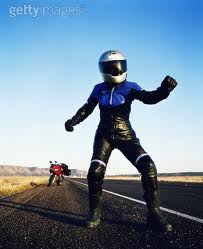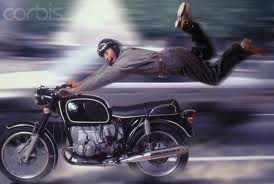
Dancing in leathers
Up until now we have been talking about how you use the controls to control the bike. Twiddling the bits so that the wobbly bits are choreographed the way we want.
But of course we have been missing the biggest and nastiest part of the whole equation to control, you the rider. In a car you sit pretty still and are held by a seat. Your movements are insulated from the chassis of the car and you weight about 1/20th of the cars weight.
Basically you can throw yourself around all over the place and the only thing you will affect is your cool factor, certainly not the cars.
On a bike though, if you are like me you probably make up nearly half the static weight of the bike and sit right up on the top of it. If you move your arm to wave at someone the bike notices.
My track bike is based on a very sharp handling road bike, its great on the track at race speeds, but I have ridden the same model on the road and you can literally change lanes by turning around to look over your shoulder!!!
Caution worse handling components
But throughout the book so far I have been telling you how you need to lean on this bit or push that bit and weight this bit and all the same time not allow your body weight to upset the bike??? How do you manage that!!!!!
The answer is of course by being VERY VERY CAREFUL about how and when you do what!!!! You might have noticed this doesn’t just apply to you and your booty.. it has also been applying to the bikes and how you move it from one state to another.
We have talked about “Sets” and “Transitions” and the same applies for your flabby bits… er sorry wobbly bits… er.. ok you get the meaning.
The Transition

Ok, so let’s get this straight. We call it transition because we are moving the bike from one stable “Set” to another, we are transitioning. This implies that when we are not transitioning we should be in a Set because we haven’t talked about any other way of being now have we!!!
Knowing that the smallest input can upset our Set we are of course being very careful when we are in a Set to just let it be and as much as possible encourage it along. We are not moving our body at all if possible and we are using the controls as little as possible.
This inturn suggests that we are getting all these control and body movements done as fast as possible during the transition phase, we are attempting to compress the period of instability into a rapid transition and encourage the Set most of the time.
Transitions can be seen as instability and obviously the place where it’s ok to do your body pushy movey thing, hopefully in the correct way but you get the idea.
Take a corner for instance, any corner. Imagine you are approaching the corner and braking heavily as you slow down for it. You are in a braking “Set” with the weight of the bike pushed forward onto the front wheel and your body weight being held firm with your legs on the tank. You are trying very hard NOT to allow your upper body to push against the bars and definitely NOT unevenly. Your keeping your hands and shoulders relaxed and trying to “feel” the brake lever response to your fingers.
Essentially you are in the Braking “Set” and trying not to upset that by allowing the worse handling part of the whole package, YOU, do something that doesn’t need to be done. You are trying to keep the weight transfer constant and allow the bike to do its thing.
But of course you are about to let go of the brake and turn into the corner, you are about to transition.
As soon as you let go of the brake the weight transfer moves around, mostly back. The front shock unloads, the rear shock starts to take weight, you body weight moves back on the seat and changes the Centre of Gravity. You are in an instable position between one Set and another.
Smoothly you swing your weight into the corner, you place your weight onto the inside peg and you push (or pull) on the bars to counter steer into the corner whilst applying a small amount of throttle. As soon as the bike has reached the lean angle you intended to dial you stop counter steering.
The bike reacts by compressing the suspension on ends, loading up the frame and “Setting” itself into a turning arc based on the speed and lean angle. It’s got itself into a corner Set and is now perfectly happy.
Right about now you are sitting stable with your weight held on the inside peg, your arms and legs holding you onto the bike but not using the handle bars for this. You have a light grip on the bars and relaxed shoulders. You have the throttle open and might be applying a steadily increasing drive through the corner.
But you are again trying desperately not to upset the Set, no bar interactions, no control inputs other than what is necessary (Throttle) you are a passenger again on a stable platform. You are even trying to avoid bumps in the road from upsetting the most wobbly bit, YOU and rallying good ol’ Newton and his third again.
When it comes time to drive out of the corner you will again counter steer (This time out of the corner), you will put much more throttle on and you’ll move your body into a stable position suitable for the Acceleration Set.
Yep that is right a corner is made up on at least two Transitions and even more if you take into account the braking part of the equation.
Please DO NOT under estimate the importance of choreography here, the Transition is you at your mark requesting the bike to do something and then allowing it to do it WITHOUT need for it to worry about you making its job harder. Riding well is really about timing, transitions and waiting for the next timing mark and therefore transition.
The best riders do not control the bike, they effectively request the bike does something and let it.



